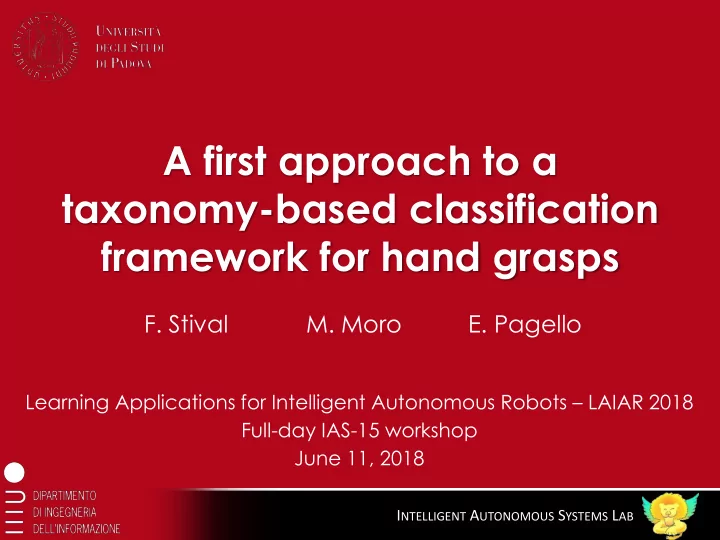

A first approach to a taxonomy-based classification framework for hand grasps F. Stival M. Moro E. Pagello Learning Applications for Intelligent Autonomous Robots – LAIAR 2018 Full-day IAS-15 workshop June 11, 2018 I NTELLIGENT A UTONOMOUS S YSTEMS L AB
Introduction IAS-L AB Interaction with robotic devices controlled by physiological human signals (sEMG) Human intention of Coherent robot movement action Emulation of the human body behaviour Alison Gibson, Mark Ison and Panagiotis Artemiadis, "User-independent hand motion classification with electromyography," ASME Dynamic Systems and Control Conference (DSCC), 2013
Strengths of the work IAS-L AB Binary classification based Taxonomy-based on a quantitative classification taxonomy of hand grasps N O V E L T Y General model built on Subject data from many different independence subjects Continuous online Online estimation of the elaboration performed movement
Subject-independent framework IAS-L AB Common underlying behavior in the task performed by different subjects Extraction of common constraints by looking to different interpretation of the task Goal Ready-to-use model : Good performances since first trials of a new user
Quantitative taxonomy of hand grasps IAS-L AB Hyerarchical binary organization of 8 significative hand grasps Considered both physical and physiological signals 40 subjects involved in the study – from NinaPro dataset
Taxonomy-based classification IAS-L AB Decomposition of the classification phase between couples of movement groups The closest to the roots the more challenging the classification but less problematic miss-classification error (the two movements will be close to each other)
Actions sequence IAS-L AB Training set (offline) Gaussian Multiple Mixture Processing Subjects Model Taxonomy- Test set (online) New based Gaussian Processing Subject Classification
Processing phase IAS-L AB Multiple New Processing GMM Processing GMC subjects subject Wavelet Transform EMG signals are non-stationary Analysis in both time and frequency Mother wavelet ( db2) 1 𝑂 Synthesis values MAV = 𝑂 𝑦 � �=1 Smoothing and Normalization
Gaussian Mixture IAS-L AB Multiple New Processing GMM Processing GMC subjects subject Gaussian Mixture Model (GMM) Gaussian Mixture Classification (GMC) 𝒎 first l samples 𝝍 𝟐 of the signal 2 considered class k total samples Selected the class corresponding to 1 2 the largest k 𝐿 Class 1 computed value ℎ = 𝜌 � 𝒪 𝜂 � ℎ ; 𝜈 � , Σ � 𝑄 𝜂 � Class 2 � 𝑑� � , � = 1. . �, 𝑗 = 1. . 𝑜 �=1 𝑄𝐸𝐺 𝜓 1 ℎ = {𝜊 ℎ 𝑢 , 𝛽 ℎ �𝑢�} ∈ ℝ 𝐸 𝜂 � Weighted sum of - Columns normalization 1. K Gaussian components - Rows averaging EMG values assumed by the Angles assumed by the Bayesian information channels at the instant t joints at the instant t criterion (BIC)
Preliminary results IAS-L AB Leave-One-Out approach on N-1 subjects and testing on new, unseen subject C O M P L E X I T Y Tested on levels of increasing complexity Movements of Level N are grouped together in Level N+1
Preliminary results IAS-L AB Results averaged fixed the level Good accuracy achieved: mean accuracy of 76.5%, reaching 97.29% in one of the higher levels Low levels: harder to classify since the movements are strictly related
Conclusions IAS-L AB Preliminar study on a subject- independent Taxonomy-based classification solution computed online using EMG signals Exploitation of a quantitative taxonomy of hand grasps Based on Gaussian Mixture Model and Classification
Conclusions IAS-L AB Good accuracy achieved: mean accuracy of 76.5%, reaching 97.29% in one of the higher levels Low levels: harder to classify since they are more related Future works: New classification algorithm Comparison of the accuracies: taxonomy vs. traditional approach
Thank you for the attention Any question?
Recommend
More recommend